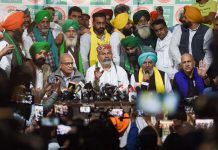
THE RITUAL started 10 years ago. That June night, the anxious parents rushed home and, on finding it bathed in darkness, quickly lit an oil lamp. The mother prayed and the father stood at the window, waiting for one of Delhi’s ubiquitous yellow-and-black threewheelers to rattle its way up their lane.
The moments ticked away. The first message —“Where are you, please call?” — had been sent to the children’s pager two hours earlier, and, unlike always, the kids had not called back. Send another message, Neelam told her husband Shekhar, as they paced up and down, waiting for the phone to ring. “Where are you?’’ reached the pager for the umpteenth time, and mechanically, as gadgets are programmed to do, the reminder tone kept beeping on a stretcher lying in the All India Institute of Medical Sciences (AIIMS).
The parents never heard from their children again. Seventeen-year-old Unnati and 13-yearold Ujjwal had succumbed to the billowing smoke that had slowly filled their lungs and asphyxiated them. They were two of the 59 who died in the Uphaar Cinema fire on June 13, 1997.
A decade later, Neelam and Shekhar Krishnamoorthy continue to light the lamp. Ask Neelam about it and the tears still come. “Does a mother stop being a mother just because her children are dead?” Look at Shekhar, and he lowers his eyes and says, “We have nothing to live for, but we have a promise to keep.’’
A promise to avenge 59 snuffed-out lives, 23 of whom were below age 15. None of the victims’ families were willing to accept the fire as something predestined. Their decade-long fight points over and over to the greed and negligence responsible for the tragedy. Uphaar’s owners — real estate magnates Gopal and Sushil Ansal — had added extra seats to the hall, which blocked the aisles and exits. The one balcony exit that could have been a lifeline that afternoon had been bolted from the outside. The manager had walked away with the cash box soon after the fire broke out. Ambulances arrived without oxygen cylinders and fire tenders turned up with empty water tanks.
The thought still haunts. None of the victims died of burns. There was not a scratch on Unnati’s body but for a lacerated ear lobe — someone at AIIMS had moved from stretcher to stretcher, yanking valuables off the dead.
Enter the Krishnamoorthy’s South Delhi flat, and facing you straight across from the front door are smiling photographs of Ujju and Niti, photographs that Neelam refuses to garland. Look left or right or into any other room and the house bears all the signs of the children as if they were still living there. Their clothes hang in the cupboard, their books and music lie where they left them, the sheet they last slept on remains untouched.
Don’t the parents want closure? How longcan they nurture the pain? “I sit in the children’s room for half an hour every single day. They guide me and give me strength,’’ is Neelam’s belief. She adds, “I don’t care what people think anymore. I am alive because of my children.”
It is probably the most painful impetus to keep the struggle going but that’s probably the only reason why the Uphaar case has not fallen by the way like, say, the 1995 Dabwali fire or the Kumbakonam inferno which killed 90 children in 2004. If, a decade down, the Ansals are still feeling the heat, there is a reason why.
For weeks after she cremated her children, the first thing Neelam would do each morning was scan the newspapers for the obituaries. “I had two choices,” she says. “I could either sit at home and cry, or go out and fight for justice.” She chose the latter because, as she puts it, “I could not sit back and accept it as fate. All my relatives advised me not to take on a powerful lobby like the Ansals. They advised me to have another child, but how could I bring another child into this world when I hadn’t been able to save the two we had?”
After the Krishnamoorthys refused to have any more children, friends and family turned away from them. Neelam and Shekhar decided to create a new family. They scoured the obituary columns and started calling up the homes of the other Uphaar victims. That’s how the Association for the Victims of the Uphaar Tragedy (AVUT) was born. On the day it came into being, Neelam made a promise to her dead children — that she would avenge them by seeing the guilty punished.
Despair and frustration have been constant companions. By day, Neelam is all grit and determination as she sits through prolonged court hearings, taking copious notes and briefing the press. Untiring when it comes to the court cases, she’s a different person back home. Tired, distraught, hurting like hell…
Strength has come through the test by fire. “I sometimes feel like I’ve been served a living death sentence,” she says. But Shekhar is there to hold her. His garment export business has more or less wound up — he needed to travel to Italy and Germany almost every month but doesn’t want to leave either Neelam or the court cases behind. He has one outlet, though: his music. And he sings those soulful melodies that pierce: Ganga aaye kahan se, Ganga jaaye kahan se— because the four Krishnamoorthys were last together on the banks of the Ganga; Tum itna jo muskura rahe ho, kya gam hai jis ko chhupa rahe ho — because Ujju used to sing it….
The mother sheds a tear again and she’s thinking the same thoughts. Did Ujju go first or Unnati? Were they together when the smoke overwhelmed them? Then the reminder that the fight must go on. Step by step, bit by bit. Defeat and despair intervene for a few moments, but the mother has a promise to keep. Not just to her children, but to the entire Uphaar family. And she waits, one court date to the next, to the next. After 10 years, the criminal case is still in the lower court and four of the 16 accused are dead.
But, as Shekhar reminds himself when he does his morning riyaz: Rahi tu mat ruk jana, toofaan se mat ghabrana, kabhi to milegi teri manzil, kahin door gagan ki chhaon mein.













